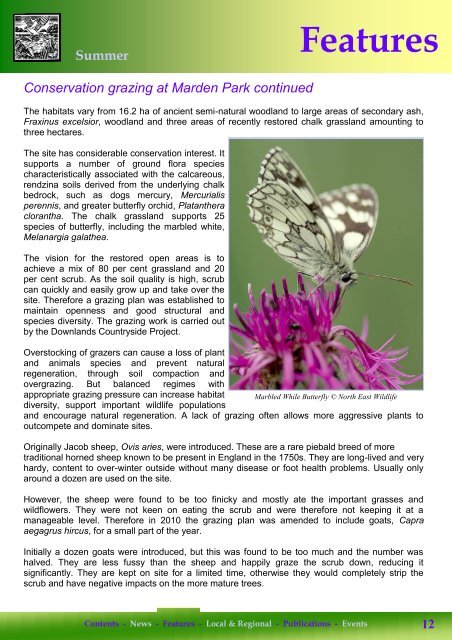Biodiversity News - Issue 61 - Tayside Biodiversity Partnership
Biodiversity News - Issue 61 - Tayside Biodiversity Partnership
Biodiversity News - Issue 61 - Tayside Biodiversity Partnership
You also want an ePaper? Increase the reach of your titles
YUMPU automatically turns print PDFs into web optimized ePapers that Google loves.
Summer<br />
Features <strong>News</strong><br />
Conservation grazing at Marden Park continued<br />
The habitats vary from 16.2 ha of ancient semi-natural woodland to large areas of secondary ash,<br />
Fraxinus excelsior, woodland and three areas of recently restored chalk grassland amounting to<br />
three hectares.<br />
The site has considerable conservation interest. It<br />
supports a number of ground flora species<br />
characteristically associated with the calcareous,<br />
rendzina soils derived from the underlying chalk<br />
bedrock, such as dogs mercury, Mercurialis<br />
perennis, and greater butterfly orchid, Platanthera<br />
clorantha. The chalk grassland supports 25<br />
species of butterfly, including the marbled white,<br />
Melanargia galathea.<br />
The vision for the restored open areas is to<br />
achieve a mix of 80 per cent grassland and 20<br />
per cent scrub. As the soil quality is high, scrub<br />
can quickly and easily grow up and take over the<br />
site. Therefore a grazing plan was established to<br />
maintain openness and good structural and<br />
species diversity. The grazing work is carried out<br />
by the Downlands Countryside Project.<br />
Overstocking of grazers can cause a loss of plant<br />
and animals species and prevent natural<br />
regeneration, through soil compaction and<br />
overgrazing. But balanced regimes with<br />
appropriate grazing pressure can increase habitat Marbled While Butterfly © North East Wildlife<br />
diversity, support important wildlife populations<br />
and encourage natural regeneration. A lack of grazing often allows more aggressive plants to<br />
outcompete and dominate sites.<br />
Originally Jacob sheep, Ovis aries, were introduced. These are a rare piebald breed of more<br />
traditional horned sheep known to be present in England in the 1750s. They are long-lived and very<br />
hardy, content to over-winter outside without many disease or foot health problems. Usually only<br />
around a dozen are used on the site.<br />
However, the sheep were found to be too finicky and mostly ate the important grasses and<br />
wildflowers. They were not keen on eating the scrub and were therefore not keeping it at a<br />
manageable level. Therefore in 2010 the grazing plan was amended to include goats, Capra<br />
aegagrus hircus, for a small part of the year.<br />
Initially a dozen goats were introduced, but this was found to be too much and the number was<br />
halved. They are less fussy than the sheep and happily graze the scrub down, reducing it<br />
significantly. They are kept on site for a limited time, otherwise they would completely strip the<br />
scrub and have negative impacts on the more mature trees.<br />
Contents - <strong>News</strong> - Features - Local & Regional - Publications - Events<br />
12

















